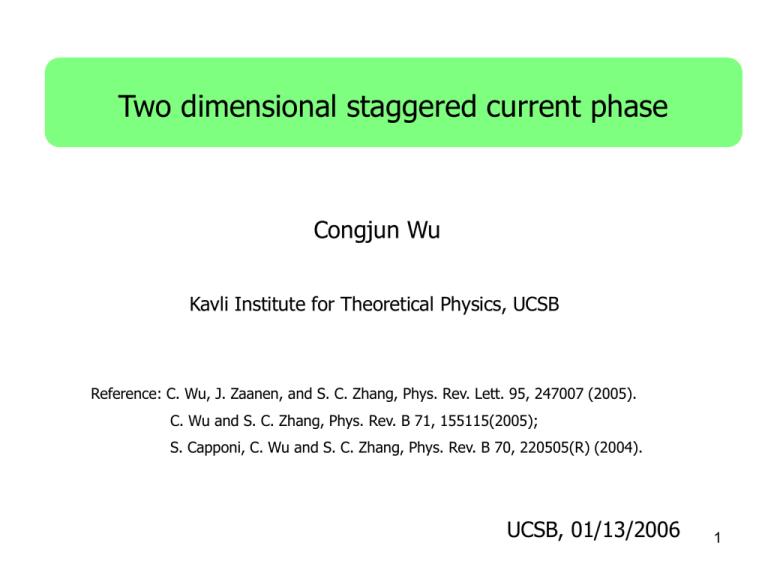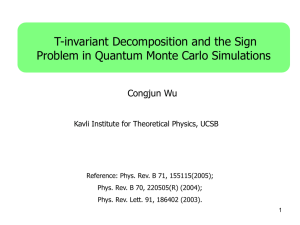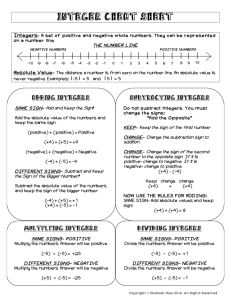Two dimensional staggered current phase Congjun Wu
advertisement

Two dimensional staggered current phase
Congjun Wu
Kavli Institute for Theoretical Physics, UCSB
Reference: C. Wu, J. Zaanen, and S. C. Zhang, Phys. Rev. Lett. 95, 247007 (2005).
C. Wu and S. C. Zhang, Phys. Rev. B 71, 155115(2005);
S. Capponi, C. Wu and S. C. Zhang, Phys. Rev. B 70, 220505(R) (2004).
UCSB, 01/13/2006
1
Collaborators
• S. Capponi, Université Paul Sabatier, Toulouse, France.
• J. Zaanen, Instituut-Lorentz for Theoretical Physics, Leiden
University, the Netherlands.
• S. C. Zhang, Stanford.
Many thanks to D. Ceperley, D. Scalapino for helpful discussions.
2
Background: pseudogap in high Tc superconductivity
• D-density wave state? It is related but different from the
staggered flux phase.
• Estimated orbital AF magnetic
moment per plaquette 1 2 B .
• Neutron scattering results
are controversial.
Chakravarty, et. al., PRB 63, 94503 (2000);
M. Hermele, T. Senthil, M. P. A. Fisher, PRB
72, 104404 (2005).
Affleck and Marston, PRB 37, 3774 (1988);
H. A. Mook et al., PRB 69, 134509 (2004).
C. Stock et al., PRB 66, 024505 (2002).
Lee and Wen, PRL 76, 503 (1996).
3
Background: T=17K transition in URu2Si2
• AF moments are too small to explain the specific heat anomaly.
• Hidden order. Incommensurate
orbit current state?
• NMR line-width broadening
below Tc.
P. Coleman, et al., Nature 417, 831 (2002).
O. O. Bernal, PRL 87, 196402 (2001).
4
Background: two-leg ladder systems
• Analytical results: Bosonization + RG.
H. H. Lin, L. Balents, and M. P. A. Fisher, Phys. Rev. B 58, (1998)
J. Fjarestad, and J. B. Marston, Phys. Rev. B 65, 125106 (2002).
C. Wu , W. V. Liu, and E. Fradkin, Phys. Rev. B 68, 115104(2003)
• Numerical results: DMRG.
Marston et. al., PRL 89, 56404, (2002); U. Schollwöck et al., PRL 90, 186401, (2003).
D. Scalapino, S. White, and I. Affleck, Phys. Rev. B 64, 100506 (2001).
5
Use spin-orbit coupling to probe the DDW phase
• SO coupling induced ferromagnetism in the DDW phase
in La2-xBaxCu2O4.
• Ferromagnetic moments ( 12 B ) along [110] direction.
• The DDW state:
The ferromagnetic state:
staggered orbital moments.
uniform spin moments.
Staggered Dzyaloshinskii-Moriya SO coupling.
C. Wu, J. Zaanen, and S. C. Zhang, Phys. Rev. Lett. 95, 247007 (2005).
6
Reliable 2D QMC results without the sign problem!
• 2D staggered currents in a bilayer model.
• Alternating sources and drains;
curl free v.s. source free
S. Capponi, C. Wu and S. C. Zhang, PRB 70,
220505 (R) (2004).
top view
d-density wave
7
Outline
• Spin-orbit coupling induced ferromagnetism in the
DDW phase in La2-xBaxCu2O4.
• The 2D staggered ground state current phase in a bilayer model.
• T-invariant decomposition and the sign problem in
quantum Monte Carlo simulations.
8
The tilt distortion in La2-xBaxCuO4
• Low temperature orthorhombic
(LTO) phase at doping<0.12.
• The Dzyaloshinskii-Moriya type SO
coupling appears in the band structure.
H0
{
c
(
t
i
ij
)c j h.c.}
ij ,
• Spin processes as electron hops in
the lattice. Time reversal invariance
requires the appearance of “i”.
9
Pattern of the DM vector
N. E. Bonesteel et al., PRL 68, 2684 (1992).
• Hermitian. ij ji
• 2-fold rotations around c axis on O sites.
i j, z z ijz zji 0
• Inversion respect to Cu sites.
i ex , y i ex , y , i eˆx , y ,i i ,i eˆx , y
• Reflection respect to the [110] direction.
i ex i e y , x , y y , x ix,,i yeˆx iy,i, xeˆ y
• DM vectors:
i ,i eˆ () (1 , 2 ,0) , i ,i eˆ () i (2 ,1 ,0)
i
x
y
10
SO coupling induced ferromagnetism in the DDW phase
• DDW as staggered charge flux.
H int,MF i Im
i
(
)
(
c
i ci e x ,
k //
ij ,
ci ci e y , h.c.)
• DM coupling as staggered
spin flux. Assume 1 2
H DM i
i
(
)
(
c
i 1, ci e x ,
ij ,
ci 1, ci e y , h.c.)
1, 2 ( x y ) / 2
• Ferromagnetic moments
appear with doping.
S / / 0.1
(t 100mev, 2 mev, 20 mev)
11
General pattern of the DM vector
• Spin polarization is fixed along the [110] direction regardless
of the ration of 1 / 2 .
F gOddw ( S x S y )
Sx+Sy
Sx-Sy Sz
DDW
TR
odd
odd
odd
odd
Two-fold
rotation
odd
odd
even
odd
even
even
odd
reflection odd
12
General pattern of DM vectors 1 2
• The magnitude of ferromagnetic moment
is also robust due to the large anisotropy of
the Dirac cones.
• Define 1 2 , 2 1
k //
k
( 2 , 2 )
H k 2ick, ( k // 1 k 2 k // )ck Q , h.c
k
• In realistic systems, 1 2 2mev .
S is only suppressed 15% compared to the value at 1 2 .
13
Experiment proposal
• Ferromagnetic moments should be easy to detect by neutron
scattering, muon spin relaxation, hysteresis behavior etc. So far,
no such moments are reported.
• SO coupling by itself does not induce spin moments in
superconducting phase due to the TR invariance.
14
Staggered spin galvanic effect
• If the DDW phase does not exists, a spin polarization along
the [110] direction can induce a DDW orbital moment.
15
YBCO system (under investigation)
• Due to the CuO pyramid, the inversion symmetry is broken
in each layer. SO coupling is the uniform Rashba type but
with opposite sign for two adjacent layers.
• Pairing structure: mixed singlet and triplet pairing.
• Rashba coupling effect in the DDW phase.
No spin moments on Cu sites, but AF moments can appear on
O sites.
C. Wu, J. Zaanen, in preparation.
16
Outline
• Spin-orbit coupling induced ferromagnetism in the DDW
phase in La2-xBaxCu2O4.
• The 2D staggered ground state current phase in a
bi-layer model.
• T-invariant decomposition and the sign problem in
quantum Monte Carlo simulations.
17
The bi-layer Scalapino-Zhang-Hanke Model
D. Scalapino, S. C. Zhang, and W. Hanke, PRB 58, 443 (1998).
c
U
t //
t
J
V
d
H t // {ci c j d i d j h.c} t {ci d j h.c} n(i)
ij
i
i
J Sic Sid U (ni ,,c 12 )( ni ,,c 12 ) (c d ) V (ni ,c 1)(ni ,d 1)
ij
i
i
• U, V, J are interactions within the rung.
• No inter-rung interaction.
18
Reliable 2D QMC results without the sign problem!
• Alternating sources and drains;
curl free v.s. source free
• T-invariant decomposition in
quantum Monte Carlo (QMC)
simulations.
• T=Time reversal operation
*flipping two layers
top view
d-density wave
S. Capponi, C. Wu and S. C. Zhang, PRB 70,
220505 (R) (2004).
19
Fermionic auxiliary field QMC results at T=0K
• The equal time staggered
current-current correlations
1
J (r ) 2 ncurr (ri )ncurr (ri r )
L i
iQr
J (Q) e J (r ) Q ( , )
r
• Finite scaling of J(Q)/L2
v.s. 1/L.
• True long range Ising
order.
t // 1, t 0.1, U 0, V 0.5, J 2.0
S. Capponi, C. Wu and S. C. Zhang, PRB 70, 220505 (R) (2004).
20
Disappearance of the staggered current phase
i) increase t
ii) increase
E U (V 34 J )
iii) increase doping
21
Strong coupling analysis at half-filling
• The largest energy scale J>>U,V.
• Project out the three rung
triplet states.
+
• Low energy singlet Hilbert space:
doubly occupied states, rung singlet state.
=
E: U
-
V 34 J
U
22
Pseudospin SU(2) algebra
• The pseudospin SU(2) algebra v.s. the spin SU(2) algebra.
c
d
ncurt (i) 2i (ci di di ci )
rung current
nbd (i) 12 (di ci ci di )
bond strength
Q(i) 12 (ci ci di di )
cdw
• Pseudospin-1 representation.
Q : 1;
0,
• Rung current states
1
| up , down
a ;
E:
U
b
V 34 J
c
U
1
2
i
2
23
Pseudospin-1 AF Heisenberg Hamiltonian
• t// induces pseudospin exchange.
t //
t //
H ex J pseudo {ncurt (i ) ncurt ( j )
ij
nbd (i )nbd ( j ) Q (i )Q ( j )}
• Anisotropic terms break SU(2) down to Z2 .
c
t
d
E
t : uniform external field
E : on - site anisotropy
1
H 2t nbd (i) E (Q 2 (i) )
2
i
E U (V 34 J )
24
Competing phases
• Neel order phases and rung singlet phases.
staggered current
CDW
staggered bond order
rung singlet
25
Competing phases
• 2D spin-1 AF Heisenberg model has long range Neel order.
t
E 0
favors the easy plane of staggered current and CDW.
favors the easy plane of staggered current and bond order.
SU(2)Z2
the easy axis of the staggered current
• Subtle conditions for the staggered current phase.
t is too large polarized pseudospin along rung bond strength
E is too large rung singlet state
t 2z J p
( z 4), 0 E zJ p
26
Outline
• Spin-orbit coupling induced ferromagnetism in the DDW
phase in La2-xBaxCu2O4.
• The 2D staggered ground state current phase in a
bilayer model.
• T-invariant decomposition and the sign
problem in quantum Monte Carlo simulations.
27
Auxiliary Field QMC
Blankenbecer, Scalapino, and Sugar. PRD 24, 2278 (1981)
• Using path integral formalism, fermions are represented as
Grassmann variables.
• Transform Grassmann variables into probability.
Probability:
positive number
Auxiliary field
QMC
Fermions:
Grassmann number
• Decouple interaction terms using Hubbard-Stratonovich
(H-S) bosonic fields.
• Integrate out fermions and the resulting fermion
functional determinants work as statistical weights.
28
Absence of the sign problem in the negative U Hubbard model
1
1
H t {c c j h.c} n(i) | U | (n (i) )( n (i) )
2
2
ij
i
i
i
• HS decoupling in the density channel.
Z dn exp{ |U2 | d (n(i, ) 1) 2 det( I B)}
0
i
• B is the imaginary time evolution operator.
B exp{ d H K H I ( )}
0
H I ( ) | U | ci, ( )ci , ( ) n(i, )
i
• Factorize the fermion determinant into two identical real parts.
det( I B) det( I B ) det( I B ) 0
29
The sign (phase) problem!!!
• Generally, the fermion functional determinants are not
positive definite. Sampling with the absolute value of
fermion functional determinants.
O sign O
/
sign
• Huge cancellation in the average of signs.
• Statistical errors scale exponentially with the
inverse of temperatures and the size of samples.
• Finite size scaling and low temperature physics
inaccessible.
30
A general criterion: symmetry principle
• Need a general criterion independent of factorizibility
of fermion determinants.
The T (time-reversal) invariant decomposition.
• Applicable in a wide class of multi-band and high
models at any doping level and lattice geometry.
Reference: C. Wu and S. C. Zhang, Phys. Rev. B 71, 155115(2005);
C. Capponi, C. Wu, and S. C. Zhang, Phys. Rev. B 70, 220505(R) (2004).
C. Wu and S. C. Zhang, Phys. Rev. Lett. 91, 186402 (2003).
31
T-invariant decomposition
CW and S. C. Zhang, PRB 71, 155115 (2005); E. Koonin et. al., Phys. Rep. 278 1, (1997)
• Theorem: If there exists an anti-unitary transformation T
T 2 1, TH K T 1 H K , TH I T 1 H I
for any H-S field configuration, then
det( I B) 0
Generalized Kramer’s degeneracy
• I+B may not be Hermitian, and even not be diagonalizable.
• Eigenvalues of I+B appear in complex conjugate pairs (l, l*).
• If l is real, then it is doubly degenerate.
det( I B) (1 1* )(2 *2 ) (n *n ) 0
• T may not be the physical time reversal operator.
32
The sign problem in spin 1/2 Hubbard model
TnT
1
1
n, TST S
• U<0: H-S decoupling in the density channel.
T-invariant decomposition absence of the sign problem
• U>0: H-S decoupling in the spin channel.
Generally speaking, the sign problem appears.
• The factorizibility of fermion determinants is not required.
Validity at any doping level and lattice geometry.
Application in multi-band, high spin models.
33
Distribution of eigenvalues
34
T=Time-reversal*flip two layers
• T-invariant operators: total density, total density;
bond AF, bond current.
c
nbond (i) 12 (di ci ci di )
n(i) (ci ci d i d i )
nAF (i) 12 (ci ci di di ) ncurt (i) 2i (ci di di ci )
d
• Absence of the sign problem at g, g’, gc>0, .
H SZH t // {ci c j d i d j h.c} t nbond (i) n(i)
ij
i
2
2
2
g {nbond
(i) ncurt
(i )} g n AF
(i) g c (n(i) 2) 2
i
i
i
i
3
J
3
4 g U V J , 4 g U V , 4 g c U 3V J
4
4
4
.
35
Summary
• Spin-orbit coupling induced ferromagnetism in the DDW
phase in La2-xBaxCu2O4.
• The 2D staggered ground state current phase in a bi-layer
model.
• T-invariant decomposition and the sign problem in
quantum Monte Carlo simulations.
36


